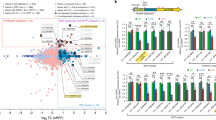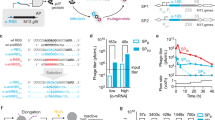Abstract
The ribosome-binding site (RBS) in the 5′ untranslated region is recognized by 16S rRNA to start translation and is an essential element of the gene expression system. RBSs have been widely applied in regulating gene expression in various scenarios, including Gram-negative or Gram-positive bacteria. Here, we first rationally designed and constructed an RBS mutant library containing 66 RBSs. The strength of these RBSs in E. coli and C. glutamicum was characterized individually. The RBS strength spanned about 200 and 15 times in the two species, respectively. The strength of RBSs in C. glutamicum was generally lower than that of in E. coli. A total of 18 RBSs showed similar strength (within twofold differences) between the species in our study, and the correlation analysis of the strength of RBSs between E. coli and C. glutamicum (R2 = 0.7483) revealed that these RBSs can be used across species. The sequence analysis revealed that the RBS region with two Ts stated was beneficial for RBS to function cross-species. The RBS characterized here can be used to precisely regulate gene expression in both hosts, and the characteristics of cross-species RBSs provide basic information for RBS rational design.





Similar content being viewed by others
References
Steitz JA. Polypeptide chain initiation: nucleotide sequences of the three ribosomal binding sites in bacteriophage R17 RNA. Nature. 1969;224(5223):957–64.
Shine J, Dalgarno L. The 3′-terminal sequence of Escherichia coli 16S ribosomal RNA: complementarity to nonsense triplets and ribosome binding sites. Proc Natl Acad Sci USA. 1974;71(4):1342–6.
Ringquist S, Shinedling S, Barrick D, Green L, Binkley J, Stormo GD, et al. Translation initiation in Escherichia coli: sequences within the ribosome-binding site. Mol Microbiol. 1992;6(9):1219–29.
Vellanoweth RL, Rabinowitz JC. The influence of ribosome-binding-site elements on translational efficiency in Bacillus subtilis and Escherichia coli in vivo. Mol Microbiol. 1992;6(9):1105–11014.
Chen HY, Bjerknes M, Kumar R, Jay E. Determination of the optimal aligned spacing between the Shine–Dalgarno sequence and the translation initiation codon of Escherichia coli mRNA. Nucleic Acids Res. 1994;22(23):4953–7.
Tuller T, Waldman YY, Kupiec M, Ruppin E. Translation efficiency is determined by both codon bias and folding energy. Proc Natl Acad Sci USA. 2010;107(8):3645–50.
Mutalik VK, Guimaraes JC, Cambray G, Lam C, Christoffersen MJ, Mai QA, et al. Precise and reliable gene expression via standard transcription and translation initiation elements. Nat Methods. 2013;10(4):354–61.
Kudla G, Murray AW, Tollervey D, Plotkin JB. Coding-sequence determinants of gene expression in Escherichia coli. Science. 2009;324(5924):255–8.
Bhattacharyya S, Jacobs WM, Adkar BV, Yan J, Zhang WL, Shakhnovich EI. Accessibility of the Shine–Dalgarno sequence dictates N-terminal codon bias in Escherichia coli. Mol Cell. 2018;70(5):894–905.
Hall MN, Gabay J, Debarbouille M, Schwartz M. A role for mRNA secondary structure in the control of translation initiation. Nature. 1982;295(5850):616–28.
Goodman DB, Church GM, Kosuri S. Causes and effects of N-terminal codon bias in bacterial genes. Science. 2013;342(6157):475–9.
Zelcbuch L, Antonovsky N, Bar-Even A, Levin-Karp A, Barenholz U, Dayagi M, et al. Spanning high-dimensional expression space using ribosome-binding site combinatorics. Nucleic Acids Res. 2013;41(9): e98.
Lin Z, Xu Z, Li Y, Wang Z, Chen T, Zhao X. Metabolic engineering of Escherichia coli for the production of riboflavin. Microb Cell Fact. 2014;13:104.
Li Y, Gu Q, Lin Z, Wang Z, Chen T, Zhao X. Multiplex iterative plasmid engineering for combinatorial optimization of metabolic pathways and diversification of protein coding sequences. ACS Synth Biol. 2013;2(11):651–61.
Zhang B, Zhou N, Liu Y-M, Liu C, Lou C-B, Jiang C-Y, et al. Ribosome binding site libraries and pathway modules for shikimic acid synthesis with Corynebacterium glutamicum. Microb Cell Fact. 2015;14(1):71.
Shi F, Luan M, Li Y. Ribosomal binding site sequences and promoters for expressing glutamate decarboxylase and producing gamma-aminobutyrate in Corynebacterium glutamicum. AMB Express. 2018;8(1):61.
Pátek M, Nešvera J, Guyonvarch A, Reyes O, Leblon G. Promoters of Corynebacterium glutamicum. J Biotechnol. 2003;104(1–3):311–23.
Zhang XM, Xu GQ, Shi JS, Koffas MAG, Xu ZH. Microbial production of l-serine from renewable feedstocks. Trends Biotechnol. 2018;36(7):700–12.
Yang S, Liu Q, Zhang Y, Du G, Chen J, Kang Z. Construction and characterization of broad-spectrum promoters for synthetic biology. ACS Synth Biol. 2018;7(1):287–91.
Cui W, Lin Q, Hu R, Han L, Cheng Z, Zhang L, et al. Data-driven and in silico-assisted design of broad host-range minimal intrinsic terminators adapted for bacteria. ACS Synth Biol. 2021;10(6):1438–50.
Patek M, Nesvera J. Sigma factors and promoters in Corynebacterium glutamicum. J Biotechnol. 2011;154(2–3):101–13.
Duan Y, Zhai W, Liu W, Zhang X, Shi JS, Zhang X, et al. Fine-tuning multi-gene clusters via well-characterized gene expression regulatory elements: case study of the arginine synthesis pathway in Corynebacterium glutamicum. ACS Synth Biol. 2021;10(1):38–48.
Martin JF, Barreiro C, González-Lavado E, Barriuso M. Ribosomal RNA and ribosomal proteins in corynebacteria. J Biotechnol. 2003;104(1–3):41–53.
Miller JH. Experiments in molecular genetics. New York: Cold Spring Harbor Laboratory Press; 1972. p. 431.
Evfratov SA, Osterman IA, Komarova ES, Pogorelskaya AM, Rubtsova MP, Zatsepin TS, et al. Application of sorting and next generation sequencing to study 5-UTR influence on translation efficiency in Escherichia coli. Nucleic Acids Res. 2017;45(6):3487–502.
Crooks GE, Hon G, Chandonia JM, Brenner SE. WebLogo: a sequence logo generator. Genome Res. 2004;14(6):1188–1090.
Xu D, Tan Y, Li Y, Wang X. Construction of a novel promoter-probe vector and its application for screening strong promoter for Brevibacterium flavum metabolic engineering. World J Microbiol Biotechnol. 2011;27(4):961–8.
Vasicová P, Pátek M, Nesvera J, Sahm H, Eikmanns B. Analysis of the Corynebacterium glutamicum dapA promoter. J Bacteriol. 1999;181(19):6188–91.
Pfeifer-Sancar K, Mentz A, Ruckert C, Kalinowski J. Comprehensive analysis of the Corynebacterium glutamicum transcriptome using an improved RNAseq technique. BMC Genomics. 2013;14:888.
Lee JY, Lee HJ, Seo J, Kim ES, Lee HS, Kim P. Artificial oxidative stress-tolerant Corynebacterium glutamicum. AMB Express. 2014;4:1–7.
Acknowledgements
This work was financially supported by the National Key Research and Development Program of China (2018YFA0900300) and the National Natural science foundation of China (32171421).
Author information
Authors and Affiliations
Corresponding authors
Ethics declarations
Conflict of interest
The authors declare no competing interests.
Supplementary Information
Below is the link to the electronic supplementary material.
Rights and permissions
About this article
Cite this article
Duan, Y., Zhang, X., Zhai, W. et al. Characterization and implications of prokaryotic ribosome-binding sites across species. Syst Microbiol and Biomanuf 2, 676–684 (2022). https://doi.org/10.1007/s43393-022-00094-8
Received:
Revised:
Accepted:
Published:
Issue Date:
DOI: https://doi.org/10.1007/s43393-022-00094-8




